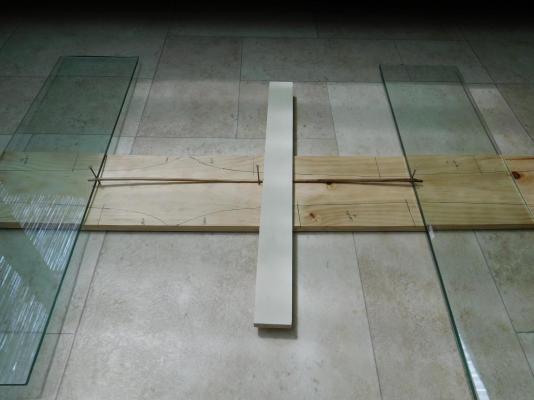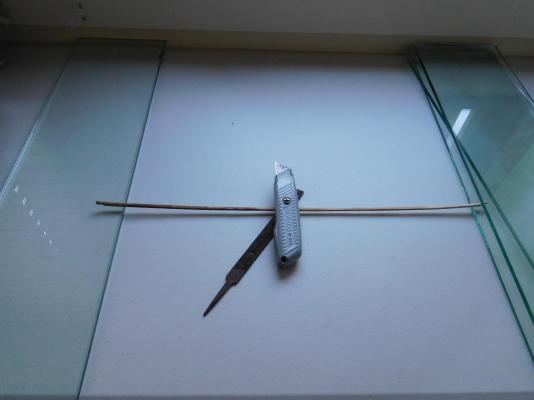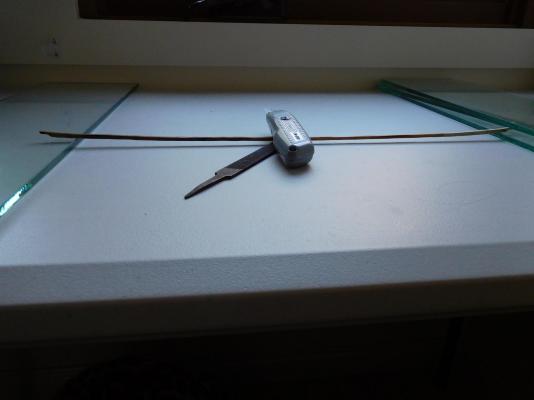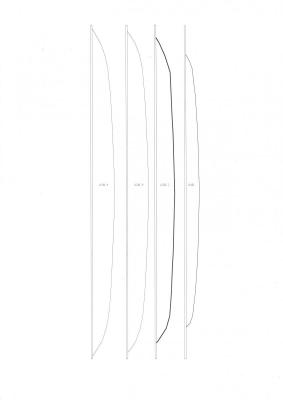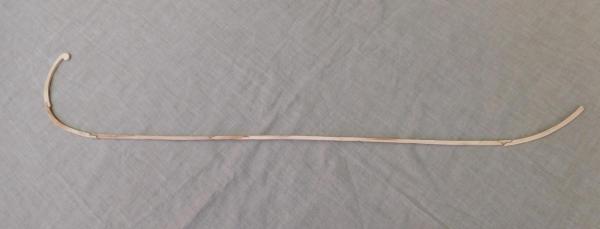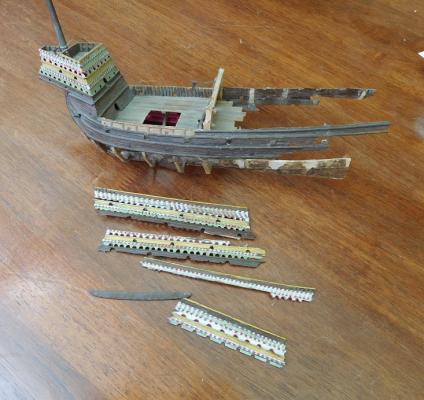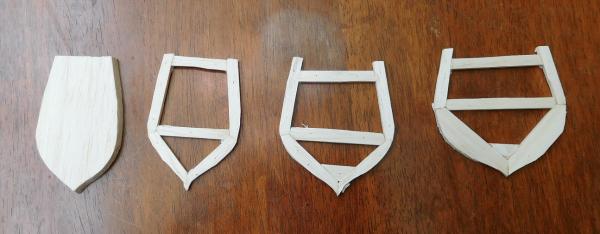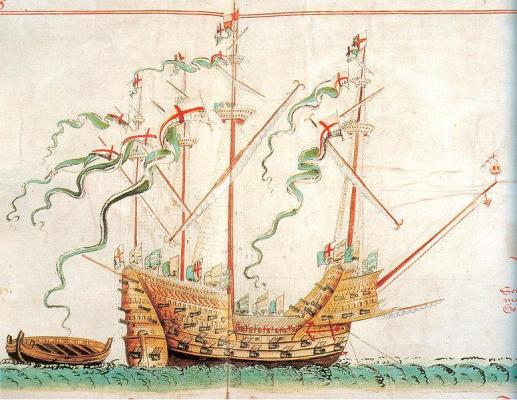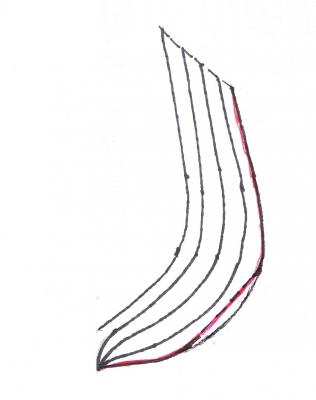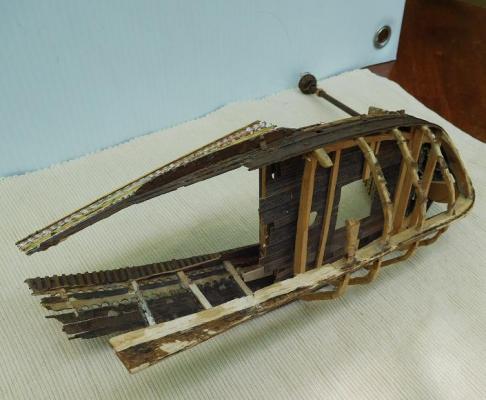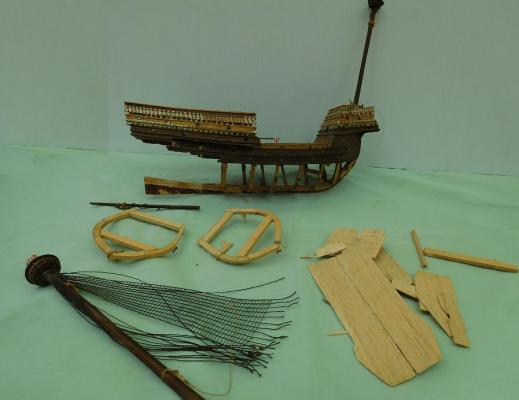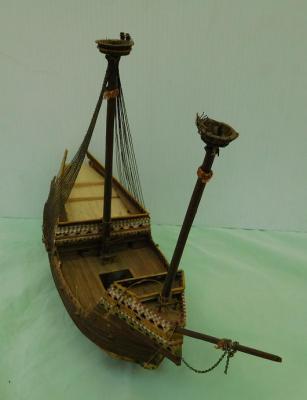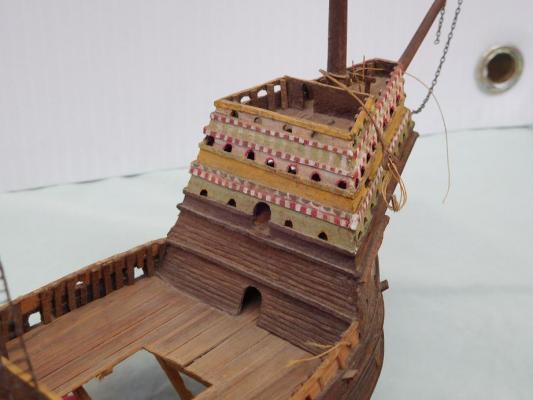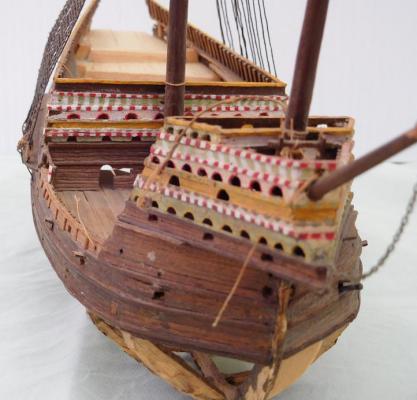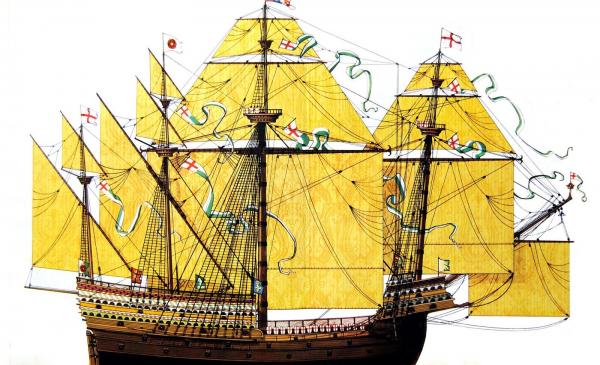-
Posts
7,987 -
Joined
-
Last visited
Content Type
Profiles
Forums
Gallery
Events
Everything posted by Louie da fly
-
That makes a lot of sense, Dick. I think the "combat" idea is more wishful thinking than based on any sort of evidence. Steven
-
Nice work, Dick (as usual). Landstro"m's book states that the grapnel was for grappling other ships in battle, but I don't know that this was based on anything other than supposition. However, the Anthony Roll depiction of the Great Harry at the very least, shows her with not only a grapnel on a chain hanging on the bowsprit, but also double-hooked yard arms. This was after all a time of transition from boarding and hand-to-hand fighting to longer distance combat with the big guns. So perhaps the grapnel is indeed for grappling other ships. Steven PS: Where did you get that lovely piece of chain?
-
Such a beautiful vessel and so expertly put together. You're an inspiration to us all, Druxey. Steven
- 641 replies
-
- greenwich hospital
- barge
-
(and 1 more)
Tagged with:
-
Thanks, Druxey. As far as I can see the grain is pretty straight, and I tried to choose as straight a grain as I could find, but I agree it will go where it wants to go. I think I'll pin it to my plug the same way you did with yours - it looks like a very good way to go. Mark, it's European plane wood, the same as the keels of several of the Yenikapi galeai were made from. I wanted to keep it as close as possible to the original; the other Yenikapi galeai had oak keels and I could have used that instead, but I've never worked with plane and I wanted to see how it went. Fortunately, Ballarat has street trees of both kinds (as well as ash, elm and other European varieties introduced by the settlers in the 19th century) and I'm able to get a lot of timber from loppings. By the way, the jig seems to have worked pretty well. I may have to do a bit of final tweaking, but I'm pretty happy with the result. Next I'll tidy up my scarph joints between keel and the stem and sternposts, and cut out the pieces for the plug. I'm looking forward to it Steven
-
A very ad hoc jig for straightening the keel in two dimensions at once. A nail at each end and one in the middle to bend the keel around in a horizontal direction, plus a sheet of glass to lift each end of the keel and a piece of wood to weigh it down in the middle. We'll see if it works . . . Steven
-
I've been trying to get the keel straight - as it's only 3mm (1/8") square and 490mm (19.3") long there's ample opportunity for it to go all bendy. It's not too bad, but when I tried correcting the sideways bowing by pouring boiling water on it, raising the ends a bit and weighing down the centre, the sideways curve corrected but the keel hogged downwards instead! And when I corrected the hogging (see picture), the sideways curve re-appeared. So, I think I need to put together some sort of jig to simultaneously correct both faults. I've got some ideas and I'll see if they work. In the meantime, I've worked out the shapes I need for the layers of the plug and I'll be cutting these out and putting them together. Steven
-
I'll give that some thought, Druxey. But as I see it, the extra work cutting the grooves might pay off in avoiding extra fiddling around trying to put the intermediate frames exactly in place. The barge is certainly very lightly built. (In comparison, the keels of the Yenikapi galeai are 6" square and the frames vary between 50 and 60mm square (2'-2.4"). But they have a fairly comprehensive system of wales and stringers to prevent hogging). I'm going to have to be careful to cut the planks exactly to prevent internal stresses as you mention above - this goes against my normal, rather slapdash approach to things (near enough is good enough). I think it's going to be quite an education in patience and precision for me. But as mtaylor says - the shipwright is slow but the wood is patient . . . Steven
- 641 replies
-
- greenwich hospital
- barge
-
(and 1 more)
Tagged with:
-
Thanks for the advice, Druxey. It's very much appreciated. I was thinking I'd have to do something like this, and I believe cutting grooves is the way I'll have to go - apart from any other considerations, the grooves should help hold the frames in place securely. But I've worked out that with a vessel about 60 cm ( 2 feet) long and frames about 5mm (1/5") apart, I'll need to cut something like 120 grooves. Dromai were incredibly lightly built - like a dinghy, but 90 feet long! Well, it should teach me patience. Your work is just phenomenal. If I can do half as well I'll be over the moon. Steven
- 641 replies
-
- greenwich hospital
- barge
-
(and 1 more)
Tagged with:
-
Thanks everybody for all the 'likes', and especially to Dick and Druxey for the kind advice on the best way to plank the ship and put in the frames. I'm still feeling my way with all this - and recessing the frames might be the way to go. Druxey, I take on board your comment about stabilizing the keel - it's been one of my major concerns. Dick, yes the Yenikapi galleys do have keelsons. It's going to be important because of the unusual method of framing in Byzantine ships - alternating frames starting from the keel with frames that crossed it. They're very close together because they're so light, so I'll have my work cut out for me. It's going to be like building a 30 metre longboat. I'm trying to approximate as closely as possible the timbers used on the original Yenikapi galleys, to get a (very) rough idea of how much one of these things would have weighed. The keels and frames seem mostly to be made of oak or of European plane and the planking is of black pine. There's ample oak and plane trees here in Ballarat and I follow the council workers around when they lop the street trees. So the keel, stempost and sternpost are of plane which I picked up off the side of the road, and I'll make the frames of it too. I can't get black pine, so I'll probably fudge it with radiata - cheap and easily available here. Steven
-
Yes, I've finally got moving after a long period of doing nothing (life getting in the way) and cut my first pieces of wood - see here. I'm pretty happy with the result, though it's very early days yet. Steven
-
Well, I’m finally back onto the dromon after a lot of waffling about trying to work out how best to build it. The true shape of a dromon’s hull is unknown and my build will be based on the theoretical reconstruction in Professor John Pryor’s book Age of the Dromon, plus very valuable insights from the wrecked galleys found at Yenikapi in Istanbul. These vessels are not dromai but the smaller lighter galeai, and I’ve extrapolated from these to get the shape of the larger vessel. It will evolve very much by trial and error. The Yenikapi galleys were incredibly lightly built – necessary when ships have to be powered by human muscle. Though they were about 30 metres (90 feet) long, their keels are made of timbers only 150mmx150mm (6”x6”), and the planks are only 20-30mm (3/4”-1.2”) thick. I’ve finally decided to build it plank on frame, but as the planks are going to be 0.5mm (1/50 inch) thick and the frames 1mm (1/25 inch) square, I’ll build it around a plug, which I’ll then remove and insert the frames within the hull. Otherwise I’m likely to smash the planking when I pick up the ship to work on it. Dromons came at a time when ships were in transition from being built planking first to frame-first, so I’m sort of following in their footsteps. I’ve been inspired by Druxey building his Greenwich barge around a plug, which has given me lots of ideas for my own build ( though I don’t think I’ll ever approach his quality of work). I’d already started making a plug out of a single piece of pine, but realised I had no idea how to get the two sides of the hull symmetrical. Taking a leaf out of Druxey’s book I’m going to make a new plug out of narrow pieces laminated together horizontally, mirrored each side of the keel, which should pretty much solve that problem. Unfortunately though the keels of the Yenikapi galleys have been found the stemposts and sternposts weren’t recovered, so I’ve had to base mine on contemporary pictures. I’ve made these, along with the keel, which is 3mmx3mm (1/8” square) in the model. A keel this thin is very given to warping and I found when I’d made mine it was a bit bowed sideways. I tried putting it in boiling water and then between two sheets of glass, but though that helped reduce the bow, it also made the keel hog, so I’ll have to try another tack – steaming and clamping. Once that’s done I’ll be putting the plug together and shaping it.
-
Druxey, your work is inspirational. I'd been planning to use a removable plug when building my dromon, but your build log has already solved several problems I'd been struggling with before I even started; for example I'd been wondering how to get the two sides identical - your solution of building up the two halves of the plug as separate mirrored units is simple and elegant. Same with the gesso and beeswax. I'll be sure to use these in my own build. I hope the plug technique works as well with carvel as with clinker construction. Many thanks. Steven
- 641 replies
-
- greenwich hospital
- barge
-
(and 1 more)
Tagged with:
-
Nice to see you back again, Dick. Excellent work as usual. You're producing a real gem. Steven
-
I've decided I'll have to strip most of the planking off after all. I'd hoped to keep a lot of it and just change the frames, but I got a lot of splitting when I was separating the old frames from the planking and it looks like I'll just have to discard most the old stuff and re-do it. I should be able to keep the forecastle, though, as it won't be affected by the changes. I've roughed out the new frames in balsa, as the original frames were. Still have to trim them down smooth. I realize they look pretty rough, but they'll be invisible and they'll do the job. As I mentioned above, this project is basically to restore the ship to the way it was when I built it - sort of a snapshot in time - and at the time I wasn't all that careful with stuff you wouldn't be able to see . When I start the next project I'll be taking much more care to get everything precise. Below are pics of the ship as it is at the moment. I've still got to get the rest of the planking off that needs to be replaced, then I need to get some veneer that matches the original (the suppliers are currently off on Christmas holidays), and get started on fixing her up properly. Kees, though the information is somewhat limited, there's far more out there than you might think, in archaeological finds, contemporary illustrations and academic papers. Have a look at Woodrat's excellent nave tonda thread to see what I mean. Steven
- 740 replies
-
- Tudor
- restoration
-
(and 4 more)
Tagged with:
-
Those are some ship names to conjure with - many referring back to the great heroes of ancient Greek history and mythology. And of course St Nicholas is a patron saint of seamen. You've done a nice job collecting all these wonderful pictures. Steven
-
That's very true, Druxey, and Landstro"m got his midships section for his Great Harry reconstruction from William Baker's diagrams. But as you say, these were quite a few decades later, and we now have the evidence of the Mary Rose, which was almost a sister ship to the Great Harry (they were built and rebuilt at almost exactly the same time as each other - but the Great Harry was one and a half times the size of the Mary Rose). I'm taking Mary Rose's shape as being more representative of the period, and that's why I'm changing the midship sections, as that way they'll be much closer to the Mary Rose. Steven
- 740 replies
-
- Tudor
- restoration
-
(and 4 more)
Tagged with:
-
Here are the only contemporary pictures of the Great Harry, from which Landstro"m did his reconstruction. The first is from the Anthony Roll of 1545 and the second is from a picture representing Henry VIII's embarkation at Dover for the tournament at the Field of the Cloth of Gold in France. Though it depicts an incident from 1520, it is thought to have been painted about 1545. Note that both pictures have to be taken with a pinch of salt. Firstly, they disagree with each other. Also, the forecastle on the Anthony Roll depiction seems to be far too large, the number of guns is probably wrong etc etc - but it has some interesting details, such as the crown on a 'spritsail mast'. Given that a "rose" emblem depicted as a figurehead on the Mary Rose in the Anthony Roll has been discovered among the remains of the ship, I'm prepared to believe the Great Harry had a decorative crown. The Embarkation picture shows a square sail on the mizzen and there are several other errors - but it does show the sails as painted to represent cloth of gold, which is in keeping with decorated sails on near-contemporary ships, and I will endeavour to replicate this on the model. Generally, I'm going to be following Landstro"m's interpretation, as I did when I began the model. I've worked out the shapes of the replacement frames, and they're shown below. The one in red is the midship frame as it it at the moment, with a black addition showing how I'm going to round it out. Steven
- 740 replies
-
- Tudor
- restoration
-
(and 4 more)
Tagged with:
-
Brian: No, I drew the plans myself based on the reconstruction drawings in The Ship. Took a lot of work, and I'm amazed it worked so well, given that the only shapes I worked out were the frames themselves - I didn't know about the other "lines" one normally uses when designing a ship. Jbshan: Yes, it's a lot easier that way. I've already drawn up the shapes of the frames to replace the ones I took out, and I'll just be gluing a bit of balsa onto the outside of the ones I keep and cut them to the desired rounded shape. Druxey, on reflection I think I may have even been 16 or 17 when I started on this. When I was 20 I was drawing up plans for a model of the Batavia (which I never built), so the Great Harry must have been complete by then. My only regret is that I didn't take a photo of her at the time. I even built a longboat out of very thin bamboo (taken from an old roller blind) - unfortunately long since lost. I put it in a safe place . . . I cheated a bit when I made the original model, though in retrospect I think I actually made things harder for myself. Rather than individual planks, I made wider "planks" and then carved them to look like there were individual ones of the usual width (you can see it if you look carefully at the photos above). I won't do that again - the curves in the wider planks were very complicated and I didn't have the skill to cut the grooves between the "planks" well enough to make it all look tidy. Interesting, though. Next thing is to remove the planking of the superstructure - I'll try to keep as much as I can intact, but with the different curvature I think I'll have to adjust the joins between the wide "planks" somewhat to follow the curve properly. Thanks everybody for the "likes". Steven
- 740 replies
-
- Tudor
- restoration
-
(and 4 more)
Tagged with:
-
Well, it's something I've wanted to do for years and never had the opportunity. In the holiday season I get at least a chance to make a start. Steven
- 740 replies
-
- Tudor
- restoration
-
(and 4 more)
Tagged with:
-
The frames were built up from balsa wood, butt-jointed together with PVA glue. It's rather amazing that it all held together all that time, but PVA glue is amazingly good (though I was a bit over-liberal with it) and balsa is stronger than most people give it credit for. The planking, superstructure and the masts and spars were made of Queensland Walnut, a native Australian timber from the laurel family. I bought a single long sheet of veneer and made everything from that. The masts and spars were made from many layers of veneer glued together with PVA and then carved to shape. The paintwork was done with Humbrol enamel and the cordage was sewing cotton. The ratlines were simply glued to the shrouds. I was about 19 or 20 when I made this and I think it holds up quite well, considering. I'd certainly do a lot of things differently today, but given my age, ignorance and lack of experience at the time, I think it's pretty good and deserves to be preserved and restored. I've taken out several of the frames and will be drafting up new set to allow a smooth transition to the narrower stern. I couldn't get the foremast out of the hull without causing damage, so I've left t in place. I'll probably still use balsa - it won't be seen and time has shown it's certainly strong enough for the job. Basically what I want to do is fix the ship up as I would have done back then if 'd had the opportunity, as it shows where I was at the time. The only things I'm likely to change in the light of present knowledge is to make the underwater section rounder in line with the Mary Rose discoveries, and make the rigging more complete, as I've learnt quite a lot more about it in the intervening years.
- 740 replies
-
- Tudor
- restoration
-
(and 4 more)
Tagged with:
-
Unfortunately I didn't take photos of the model when it was in good condition. What I have now might give some idea of what it was like before I stated messing with it and time and carelessness took their toll.
- 740 replies
-
- Tudor
- restoration
-
(and 4 more)
Tagged with:
-
I built this model of the Great Harry back in about 1970 when I was a teenager. I'd previously made models from plastic kits and carved from solid blocks of wood, but this was the first time I'd tried a plank-built model. It was based on the reconstruction in Björn Landström's excellent book The Ship, which showed a copy by the author of the Anthony Roll illustration of 1545, and the author's conjectural reconstructions of a midship section and a side view of the ship above the waterline. All of this was before the raising of the Mary Rose, so it was based on far less information available than we have now. I drew up a set of plans and proceeded to build the model. I got the hull complete and painted, added masts and spars and sails, and was adding shrouds, deadeyes and ratlines (nowadays I'd do this before I added the spars, but I've learned a lot since then). I even had a couple of figures on deck and another in one in the mizzentop. Unfortunately I'd made the stern far too wide and when I saw another picture of the ship by the same author, showing her with a far narrower stern, I decided to pull the stern off and fix it. Then life got in the way. Suddenly I had to move to the other side of Australia, about 4000 km (2500 miles) away and never got a chance to revisit the model. It stayed in its box, getting progressively more damaged as I repeatedly moved house. I've lost track of a lot of the stuff that broke off over the years, the sails went dark brown and started to rot. Finally, after all these years I've had the chance to revisit and, I hope, return the ship to her former glory.
- 740 replies
-
- Tudor
- restoration
-
(and 4 more)
Tagged with:
-
The classical idea of Charon is that he was just a ferryman . . . as in the images here and here. Maybe a bit forbidding, but not ghoulish.He was part of the ancient world's catalogue of mythical figures, not something to scare kiddies with. On the other hand, tastes have changed and what you portray is totally up to you. Steven
About us
Modelshipworld - Advancing Ship Modeling through Research
SSL Secured
Your security is important for us so this Website is SSL-Secured
NRG Mailing Address
Nautical Research Guild
237 South Lincoln Street
Westmont IL, 60559-1917
Model Ship World ® and the MSW logo are Registered Trademarks, and belong to the Nautical Research Guild (United States Patent and Trademark Office: No. 6,929,264 & No. 6,929,274, registered Dec. 20, 2022)
Helpful Links
About the NRG
If you enjoy building ship models that are historically accurate as well as beautiful, then The Nautical Research Guild (NRG) is just right for you.
The Guild is a non-profit educational organization whose mission is to “Advance Ship Modeling Through Research”. We provide support to our members in their efforts to raise the quality of their model ships.
The Nautical Research Guild has published our world-renowned quarterly magazine, The Nautical Research Journal, since 1955. The pages of the Journal are full of articles by accomplished ship modelers who show you how they create those exquisite details on their models, and by maritime historians who show you the correct details to build. The Journal is available in both print and digital editions. Go to the NRG web site (www.thenrg.org) to download a complimentary digital copy of the Journal. The NRG also publishes plan sets, books and compilations of back issues of the Journal and the former Ships in Scale and Model Ship Builder magazines.




